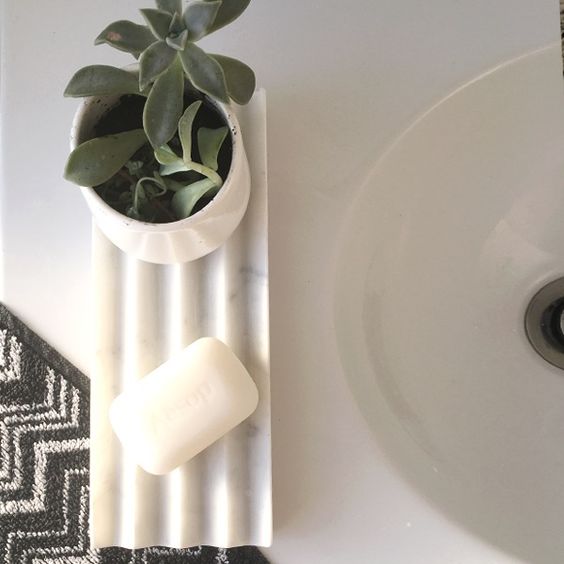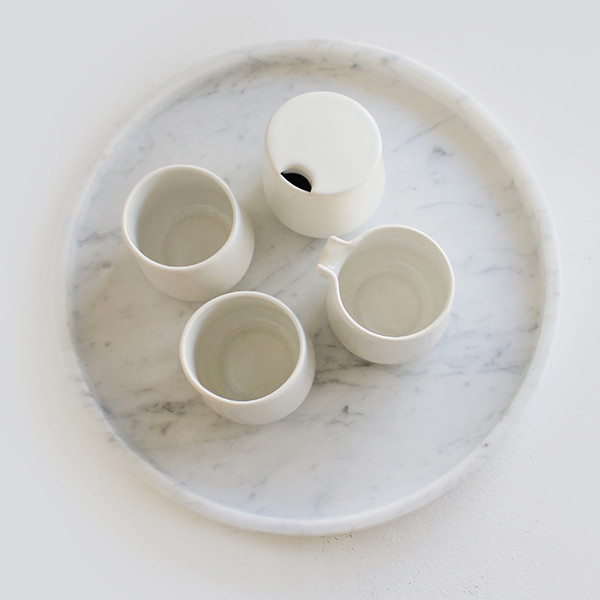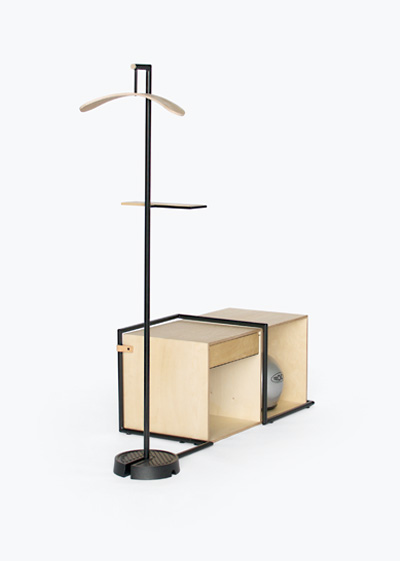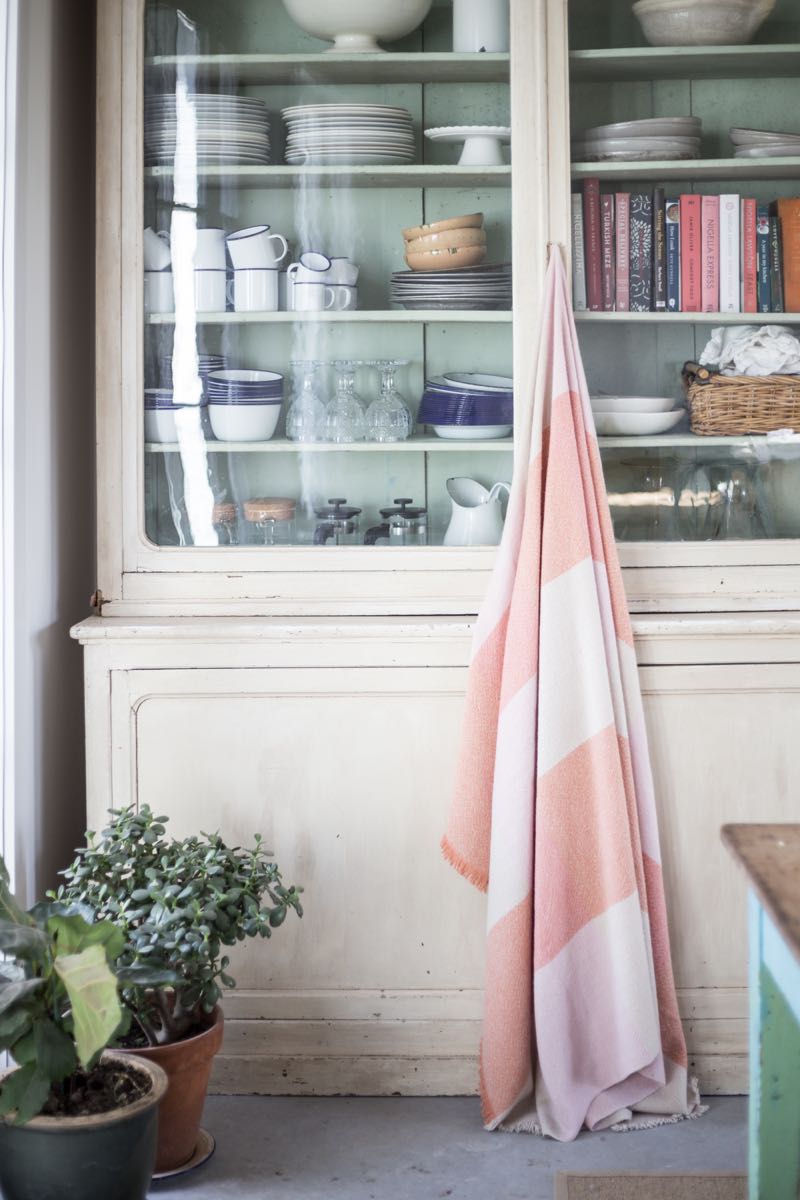I have to admit that accessories are often given less attention than they deserve here at Design daily. A new furniture or lighting collection generally gets coverage rather than an equally well designed and made homewares item. So this post is to highlight a few new (and newish) Australian designed products that fall into this category.
Oh, and there are a few new lights which I couldn't resist including as well.
Cindy Lee Davis established her brand ‘Lightly‘ in 2005 incorporating lighting and furniture but with a heavy emphasis on accessories. In recent years the products she has designed have evolved to a warmer, simpler aesthetic that embraces natural materials and the tactility that comes with this. Her latest range of interior objects release towards the end of last year under the collection name of Infinitude, are a vast range of vessels, chopping boards, salad serves and all manner of other tableware items. Some, like the items above are made from Soapstone, a material used in sculptural stone carvings for centuries. In addition to these vessels, Lightly released a turned pendant light in the same material called 'Gibson', which joins the brand's range of spun metal lights. The Infinitude collection also includes pieces in copper and brass and as seen below, in maple with brass inlay.
Armadillo & Co is an Australian rug brand that has also been around for a number of years but which has recently added 100% wool rugs to their previous ranges made predominantly from Bangladeshi Hemp. or in a combination of hemp and wool. Co-founded by Sally Pottharst and Jodie Fried, the brand sources its rugs ethically from small makers in India and supports these communities through donating a percentage of their profits to build pre-schools. For more on Armadillo & Co's Anganwadi Project click here. This year has seen the relies of six new rugs in the 'Lattitude' collection - hand knotted rugs in a Berber style. The look of the rugs varies from quite minimal to bold contrasting patterns as in the Zulu rug pictured below that combines a strong Zulu feel in the darker areas with a more delicate fine diamond pattern commonly found in Moroccan Ben Ourain rugs.
Moroccan born, Melbourne-based Designer, Abde Nouamani recently travelled to Canada as part of an exchange programme with the Ontario College of Art and Design in Toronto and studied ceramics under Alissa Coe. While in the past he has worked mainly in furniture design , ceramics seem to have a struck a chord and his new 'Ceramic Experiments' looks like being the start of an ongoing interest in the material. Nouamani has twice been a finalist in the Vivid design awards and has exhibiting at events such as Melbourne's Fringe furniture and at Render, Brunswick Street Gallery. While in Toronto he also exhibited at Designboom mart, as part of the city's Interior Design Show (IDS). While ceramics have been absorbing much of his time lately he has also released a furniture range called 'Naive' in collaboration with Melbourne furniture makers, Smith & Thomas. You can see the 'Naive' range here.
A brand new release, the 'Melt' wall sconce by Melbourne based lighting studio, Articolo Architectural Lighting, captures glass at a point before the molten hand-blown glass flops back on itself. The shapes are soft, irregular and totally beguiling. The centre of the light is in a more opaque glass to provide a better distribution of light. Available in two subdued colours, smoke and grey, or for a bolder look in emerald green and peacock blue. Articolo was founded by Nicci Green in 2010 and produces all its lights in Australia using local artisans with a special emphasis on the unique qualities of handblown glass.
Young Sydney designer Henry Wilson features regularly on Design daily and for good reason. HIs highly reductive approach has led him to work on stores interiors for brands like Aesop while he has repeatedly won awards for his simple but beautifully considered furniture designs. A recent addition to his ever growing range of sand-cast metal objects is the 'Bronze Surface' light shown below. Wilson contrasts the irregularities inherent in the sand-casting technique with the smooth, highly polished look that can be achieved when the casting is ground back and meticulously polished.
One of the most enduring names in Australia's design scene is Marc Pascal. The Melbourne-based lighting and object designer has been pushing the boundaries of design since he first founded his studio in the mid 90's. HIs work has always been highly influenced by natural forms and in his new lighting piece 'Leefy See Dragon' (correct spelling) he has designed a light fitting that can be used horizontally, vertically or at an angle, in a long loose arrangement of 14 LED bulbs. The form has the irregular feel of seaweed in this form but is also avail be in a star shape that appears less organic and more futuristic.
Marble is going through a total renaissance with just about every designer turning their hand to producing something in this enduring material. The beauty of stone when honed rather than polished is that it is visually soft while hard enough to cut and turn into precise shapes. Sydney's Evie Group (Dominic Chong and Alex Gilmour) have released a grooved tray called 'Chevron' and a round platter/tray with a pronounced lip simple called 'Round tray'. These gentle objects join their recent 'Oliver' side table designs that feature circular marble tops on minimal metal bases.
Esko is a new brand established in early 2016 by The first collection is a range of lidded stoneware vessels made in Ubud, Bali. Available in two colours - a sort of terracotta red brown the brand calls 'Cinnamon' and a soft off-white. With the exterior left unglazed the vessels have a soft organic feel. The brand hopes to add new products soon and continue to work in a clean, simple aesthetic style influenced by Japanese and Scandinavian design. Like Armadillo & Co discussed earlier Esko are committed to fair trade practices and are donating 10% of the brand's profits to charities.
The use of continuous lines in furniture design has been a strong trend for a couple of years lead by big names like Japanese designer, Nendo. Australian design studio Yellow Diva has putter particular stop on the concept creating 'Hang', a range of wardrobe and storage pieces designed for domestic and cooler office spaces. The original piece shown on the right below was called 'Hang' but this has been joined by more extensive versions such as 'Hang 10' (shown on the left) where several coats can be hung and things like umbrella and plant holders are included along with a mirror and a small amount of concealed storage.
Another strong trend in the last few years has been the re-introduction of plants into interiors. Botanica Boutique is a brand that has developed a micro vessel for greening your environment called 'Sanctuary'. Their moss garden combines a perspex material for the cloche-like dome with either a concrete or marble base. The design works like a modern version of a terrarium with he roof of the dome converging to a point that forces condensation back onto the moss. This has to be the easiest introduction to gardening one could imagine and it is sized in such a way that even the smallest apartment can accomodate one, two or a whole group of them. The S-Lux Sanctuary is available in four types of marble: Carrara (white), Nani Marquita (black), Empress (Green) and Dark Emperor (brown).
While some of the new lighting by Volker Haug was discussed in the Design Daily post on Denfair 2016 (click here to read more), I thought D.d should show another of Haug's new standout designs that adds pink marble to a long brass rod to create a unique and beautifully delicate pendant lamp. 'Discus' is available in brushed or polished brass with the option to have two large marble discs or five smaller ones.
Karina Pires is a Brazilian wallpaper and textile designer who moved to Sydney in 2000 and who started her own brand, House of Six, in 2012. The first collection consisted of wallpaper designs exclusively sold through Emily Ziz Studio in Paddington but Pires has since concentrated more on textiles which she weaves herself on mechanical looms. The chunky 'Fisherman's throw shown below is one of a whole collection of throws, cushions and blankets woven by the designer in merino wool.
Pires' 'Grid' throws (shown below) and cushions are available through Sydney homewares emporium Koskela.





















